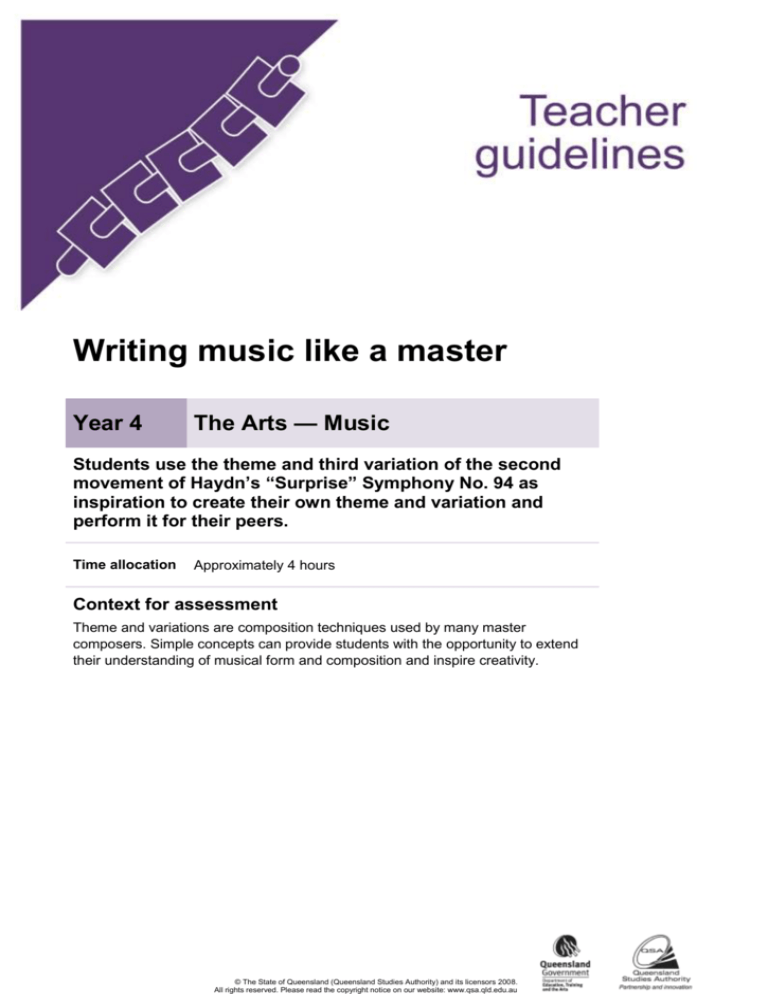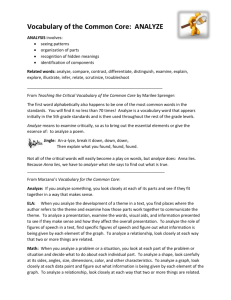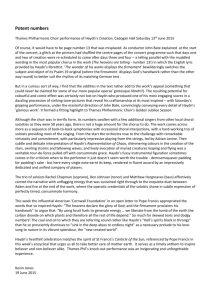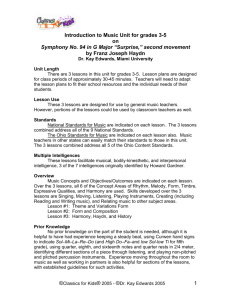
Writing music like a master
Year 4
The Arts — Music
Students use the theme and third variation of the second
movement of Haydn’s “Surprise” Symphony No. 94 as
inspiration to create their own theme and variation and
perform it for their peers.
Time allocation
Approximately 4 hours
Context for assessment
Theme and variations are composition techniques used by many master
composers. Simple concepts can provide students with the opportunity to extend
their understanding of musical form and composition and inspire creativity.
© The State of Queensland (Queensland Studies Authority) and its licensors 2008.
All rights reserved. Please read the copyright notice on our website: www.qsa.qld.edu.au
Teacher guidelines
This assessment gathers evidence of learning for the following Essential Learnings:
The Arts
Essential Learnings by the end of Year 5
Ways of working
Knowledge and understanding
Students are able to:
Music
select and develop ideas
for arts works,
considering different
audiences and different
purposes, using arts
elements and languages
rehearse and rework arts
works, using interpretive
and technical skills
present arts works to
informal and formal
audiences, using arts
techniques, skills and
processes.
Music involves singing, playing instruments, listening,
moving, improvising and composing by selecting the music
elements to express ideas, considering different audiences
and different purposes, through sound.
Duration, beat, time values and metre are used to create
rhythmic patterns.
Pitch and intervals are used to create the melodic
arrangement of sound.
Musical forms are used to structure music.
Relative softness and loudness and articulation of sounds
are used to change dynamic levels and expression of music.
Assessable elements
Knowledge and understanding
Creating
Presenting
Source: Queensland Studies Authority 2007, The Arts Essential Learnings by the end of Year 5, QSA, Brisbane.
2
Year 4 The Arts — Music: Writing music like a master
Listed here are suggested learning experiences for students before attempting this assessment.
Learn and practise using and writing rhythmic patterns appropriate for the student cohort.
Practise identifying and writing simple rhythmic patterns in many contexts.
Learn about rhythmic and melodic form.
Look at and listen to other examples of theme and variations.
Practise identifying the rhythmic and melodic form of many songs.
Learn about theme and variations form.
Practise using Haydn’s variation technique with known songs.
Practise singing, playing and writing the do pentatonic scale.
Practise reading, writing and performing rhythmic and melodic scores.
Practise reading, writing and playing dynamics.
Practise using tuned classroom instruments for melodic performance (e.g. xylophone;
glockenspiel, recorder).
Teacher resources
Piano sheet music of Haydn’s theme: <http://gardenofpraise.com/key21bj.htm>.
Classics for kids: <www.classicsforkids.com/teachers/lessonplans/haydn/haydnK1.asp>.
This website includes:
a pictorial listening map for Haydn’s “Surprise” theme
a listening map with rhythms
a map with dynamics
information about Haydn
an excellent recording of the second movement. For this assessment, students need to listen
to the first half of the theme, which on this recording is from 00:00 – 00:34 seconds, and the
third variation, which can be heard from 03:11 – 03:27.
3
Teacher guidelines
Preparing
Consider these points before implementing the assessment.
Decide how students will perform their theme and variation.
Make sure that your students are very familiar with the instruments you plan to use.
Implementation
Consider these points when implementing the assessment.
It is suggested that this assessment be undertaken in small sections over a number of weeks.
Some students may find performing solo particularly confronting. It may be appropriate to allow
some students to perform in pairs or to allow students to perform in front of a small group of
close friends, or for the teacher alone. It is important for the performance to be a positive
experience that builds confidence.
4
Year 4 The Arts — Music: Writing music like a master
Sample implementation plan
This table shows one way that this assessment can be implemented. It is a guide only — you may
choose to use all, part, or none of the table. You may customise the table to suit your students and
their school environment.
Suggested time
Student activity
Teacher role
Resources
Section 1. A master’s “surprise”
Haydn’s theme
10 minutes
Listen to the first part of
Haydn’s “Surprise” theme.
Students identify how many
phrases there are, how many
times the same melody is
repeated, and what is
different on the repeat of the
melody.
Guide student listening. Recording of the
second movement
Encourage students to
of Haydn’s
move to the rhythms of
“Surprise”
the theme and variation
Symphony No.94
to help them feel how
(see Teacher
the rhythm changes.
resources).
Students clap and move to
the rhythm and hum the
melody.
10 minutes
Students write the rhythm of
the first 16 beats of the
theme into the beat boxes
provided.
Have the students first
point to the beat boxes
as they hum the
rhythm, so they can
decide how many
sounds are heard on
each beat.
5 minutes
Students identify the melodic
form.
Guide student listening.
Haydn’s variation
5 minutes
Listen to the 3rd variation of
Haydn’s theme.
Students clap and move to
the new rhythm and hum the
melody.
10 minutes
Students write the rhythm of
the first 16 beats of the
variation into the beat boxes
provided.
Students identify whether the
melody has changed
separately from the rhythmic
change.
Guide student listening. Recording of the
second movement
of Haydn’s
“Surprise”
Symphony No.94.
(see Teacher
resources).
Have the students first
point to the beat boxes
as they hum the
rhythm, so they can
decide how many
sounds are heard on
each beat.
5
Teacher guidelines
Section 2. My theme
5 minutes
Students write their own
rhythmic theme using ta’s,
ti-ti’s and za’s.
Guide student writing.
10 minutes
Students write their own
melody using the do
pentatonic scale.
Have the students sing
the do pentatonic
scale.
Remind students to
use the same form as
Haydn.
Section 3. My variation
10 minutes
Students write their own
rhythmic variation using
known rhythms.
Guide student writing.
5 minutes
Students add their melody to
their varied rhythm.
Remind students that
their melody should
remain the same as the
one they used for their
theme (altered by
rhythm only).
Section 4. Write your music like a master
30 minutes
As a class, write the first 2
Help the students to
bars of Haydn’s theme on the decide what time
manuscript.
signature is required,
and how many beats
Students write their theme
they will need to write
and variation on the
per bar.
manuscript provided.
Section 5. Perform your theme and variation
30 minutes
Let students rehearse their
theme and variation.
Guide student
rehearsal.
Have students practice for
each other and provide
constructive feedback.
Dependant on
class size
Students perform their theme
and variation for their peers.
Instruments or
voices.
Appendix A, Music
word bank.
Teacher guides the
performance order and
ensure appropriate
audience behaviour.
Instruments or
voices.
Resources for the assessment
Appendix A
Music word bank — This is a bank of safe words that students can use when giving
peer feedback.
Appendix B
Melody for Haydn’s “Surprise” theme and 3rd variation from Symphony No. 94,
Movement 2.
6
Year 4 The Arts — Music: Writing music like a master
During the learning process, you and your students should have developed a shared
understanding of the curriculum expectations identified as part of the planning process.
After students have completed the assessment, identify, gather and interpret the information
provided in student responses. Use only the evidence in student responses to make your judgment
about the quality of the student learning. Refer to the following documents to assist you in making
standards-referenced judgments:
Guide to making judgments
Indicative A response
Sample responses (where available).
Making judgments about this assessment
This assessment assesses students through three task-specific assessable elements. Teachers
may wish to judge these areas separately making an on balance judgment.
For further information, refer to the resource Using a Guide to making judgments,
available in the Resources section of the Assessment Bank website.
Evaluate the information gathered from the assessment to inform teaching and learning strategies.
Involve students in the feedback process. Give students opportunities to ask follow-up questions
and share their learning observations or experiences.
Focus feedback on the student’s personal progress. Emphasise continuous progress relative to
their previous achievement and to the learning expectations — avoid comparing a student with
their classmates.
Giving feedback about this assessment
Have students listen to each others performances during the rehearsal phase and give each
other feedback. Guide students on how to give positive and constructive feedback. See
Appendix A, Music word bank, for safe word suggestions.
Give students regular feedback about how they can enhance their performance.
For further information, refer to the resource Using feedback, available in the
Resources section of the Assessment Bank website.
7
Appendix A
Music word bank
Teachers should be sensitive to issues that may arise as students respond to their own work and
that of other students. It may be useful to develop a list of appropriate and safe words that can be
used to describe peer performances. This will help increase students’ Arts vocabulary and allow
them to show empathy toward others.
Brainstorm ideas with students and add to this list.
Safe words to help discuss music
Words for performance
fluent
interesting
exciting
clear
in time
rhythmic
in tune
accurate
musical
contrasting variation
uses dynamics
catchy
melodic
Appendix B
Melody for Haydn’s “Surprise” theme and 3rd variation from Symphony
No. 94, Movement 2.










